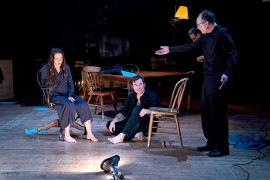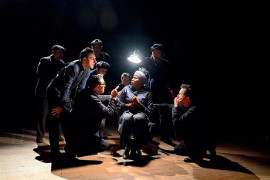
Eric
Uhlfelder
ALTERNATIVE FACTS
THE
CRUCIBLE I have no doubt if Eric Tucker was given a shoebox in which to direct a play, he could concoct a hit. Played out across his trademark minimalist staging that focuses attention on actors and their words, Tucker’s latest production--Arthur Miller’s “The Crucible”—is extraordinary.
The 150-seat Connelly Theater at 220 East 4th Street intimately embraces this dynamic show of 14 superb actors led by the remarkable performances of Ryan Quinn (as John Proctor), Susannah Millonzi (Elizabeth Proctor), and Tucker (as Reverend Hale). A crucible, according to the Miriam Webster dictionary, is “a place or situation in which concentrated forces interact to cause or influence change or development.” Miller couldn’t have selected a more apt title. Based on the Salem Witch Trials of the 17th century, Miller was contemporaneously inspired by Joseph McCarthy’s House Select Committee Hearings on UnAmerican Activities. In both instances, moral pretense provoked immoral behavior to prove its existence when there wasn’t any. In pleading to the court that it not be hoodwinked by pleas of innocence, Reverend Parris (Randolph Curtis Rand) fails to realize his own misguided accusations of witchcraft: “We are here, Your Honor, precisely to discover what no one has ever seen.” The tale’s timeless theme: a blind search for truth can easily get distorted when ulterior motives inevitably come into play.
Throughout, Miller shows how complicated life in fear can be. And Tucker’s penchant for chaos complements the confusion that tears through Miller’s characters. He has players over-talking one another in pitch-perfect cacophony. Actors effect frenzied set changes in the middle of the action, and they cross through the audience, bringing theater-goers into the mix. Confrontations are raw and real. And by the end of the show, the set appears as if a storm had blown through, leaving the play without resolution. When the playwright looked back at his tale four decades after he wrote it in 1953, Miller rediscovered: “That John Proctor the sinner (adultery with one of the accused girls) might overturn his paralyzing personal guilt and become the most forthright voice against the madness around him . . . and, I suppose, an inspiration: it demonstrated that a clear moral outcry could still spring even from an ambiguously unblemished soul.” The play’s connection with today’s world is inescapable. |
| recordings | coupons | publications | classified |



